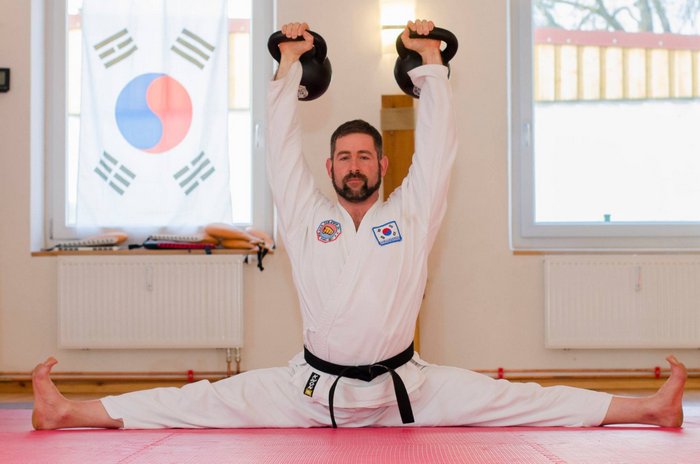
If after reading the headline, you expect me to give you advice on how you can get rid of your significant other, I am sorry to disappoint you. As husband to a beautiful wife and father of two sweet kids, I am simply not qualified to give you advice on that. I am however qualified to answer the question of how you can achieve a full split even if you are distinctly beyond your teens. It is a common misconception that once you have grown out of your teenage years it becomes impossible to achieve flexibility feats like the full front or side split. Let me tell you–this is definitely not the case. How can I know it? Simple: I achieved my first full split at age 40 and have now at 42 reached a level of mobility that I can do it practically every day if I please.
Before I tell you what helped me to finally get my split, let’s first get one thing straight: learning to do a full split should not be your goal just for the sake of it. If you need the flexibility because you are a martial artist like me, a dancer or yogi or otherwise need it for your sport–then go for it. If you have no definite reason to learn the splits, however, I would not advise you to add it to your list of goals. I write this for two reasons. Number one: the split does not come easy, if done properly it is a feat of strength and flexibility that requires months if not years of dedicated training. Reason number two is that it comes at a cost. Moving well in this extreme range of motion requires a very specialized kind of strength. If you don’t spend the time and effort necessary to develop this specific kind of strength, you risk the integrity of your hip and knee joint. Also training for the split will likely interfere with your other training. It’s too much bother just to get a cool looking picture! Use the concepts I will lay out in this post to archive the level of mobility you really need and then go on and pursue your other goals.
How Genetics Impact Flexibility
Everyone knows there are people who are very flexible by nature and there are those who are stiff. In which category you belong is determined by your fascia. If you are fairly young and female, chances are good that your connective tissue is soft and you can get your split fairly easily–if you are in this situation please take my advice and make an effort to strengthen your legs and core before you go for the full split. This will take a little longer but your joints will thank you for it. The fastest way to your goal is not always the best.
Should you, like me, not belong to this gifted group of individuals, I have good and bad news for you: the good news is that it is still both possible and achievable to do a full split; the bad news is that you will have to put in more work and dedication to achieve your goal.
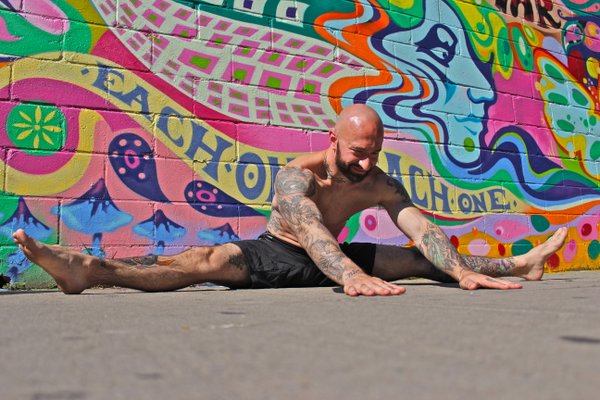
Understanding the Split
A split is the ability to sit on your butt while having your straight legs either out to the side or one in front and one behind you.
As there is no tissue in the body that connects your legs directly to one another, doing a split should be easy, right? I have been told, but have not seen it personally, that a fully sedated person can be positioned in a split no matter if this person can do so while awake. Anatomically there is no real reason why not everybody should be able to do that. The ability to perform a split (or not) lies in our nervous system rather than in our joints or muscles.
There is a right way to achieve your split and a wrong one. If you pick the wrong one you will find that you get problems in your hip and or knees because you “stretched” bands and ligaments instead of your muscles. In the German language this is called joint cavity mobility. I personally tested this approach in my early Tae Kwon Do career and cannot recommend it.
The correct route is to keep your joints tightly in the socket and lengthen your muscles enough to allow for the desired range of motion. This is also good news for people like me, who passed their twenties without achieving the split. The older you get the harder your connective tissue tends to become–but your muscles do not lose the ability to lengthen with age.
Why is it that average people tend to get stiffer as they age? The answer is simple yet profound: You lose your mobility if you do not use it on a regular basis. Our average contemporary moves less with every passing year and thus also get stiffer. Here in Europe, we have a great example of this process at work: in the more southern parts of Europe like Italy and parts of France, public toilets are usually designed for standing use–in order to do what you have to do, you need to get into a decent (and hopefully stable) deep squat. Guess what: the number of people with a good squat is much higher in the southern parts.
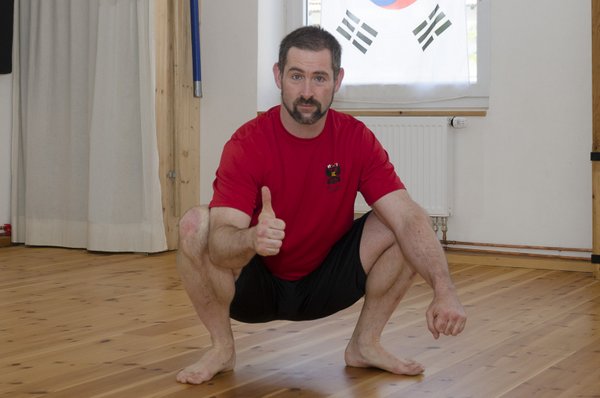
Rules for Stretching:
1 – Always use tension
Granted if you stay loose while stretching you will get deeper, but the additional ROM does not necessarily come from the joints you’re trying to stretch, but rather from its neighbors. This does not make you more mobile but sets you up for injury as you weaken joints that are not meant to be mobile–in the case of the split this would be the knees and the lower back. Therefore it is imperative to hold everything tight and only loosen the exact joint you are targeting.
2 – Never force it
Pretty much every body can learn a full split – but not everybody can do every split. If you look at x-rays of the hip joint from different people, you will notice that there are distinct differences that impact the way somebody is most likely to get into his split. The longer the femoral neck and the more shallow the socket of the hip joint is the easier it will be for that individual to get into the a split. I have shallow sockets but a short femoral neck–therefore you will never see me sitting in the split with my toes pointing forward.
Whenever you find a blockage during a stretch, don’t try to lever through it–simply find a better way.
3 – Understand the pain
Pain is a signal–and to do extreme stretches without injury you need to be able to interpret those signals correctly. For somebody new to stretching, the discomfort involved is usually mistaken for pain–which it is not. It is simply your nervous system trying to talk you out of the idea. Like your mother used to tell you not to go too deep into the woods when you were a kid, your nervous system does not like to explore unknown joint angles. If you are like me–you did not really listen to your mother, but you used caution while exploring the unknown. In my eyes this is the right approach for stretching also: get used to the sensation, try to enjoy it and avoid suffering. Always listen to the warning signals your body sends and back off when necessary.
4 – Mobilize first
No matter which position you’re in, always try to mobilize before you go deeper into it. When you approach the outer limits of your current ROM your joints usually feel very tight and immovable. Instead of forcing your way through this tightness you should try to make small movements until you feel less tight. Only then it is time to progress deeper into the stretch.
5 – Take time to recover
In order to stretch, your main movers need to lengthen, allowing for the increased ROM, while the smaller stabilizer muscles must protect your joints. If you are wise, you back off after every max attempt and give yourself time to recover. Every time I achieved a new PR in my journey to the split I’d take a break – sometimes as long as two weeks before I restarted my split training. In my opinion this is the reason why most people fail to reach these levels of mobility – they go too hard for too long time and the CNS finally sets its parking brake.
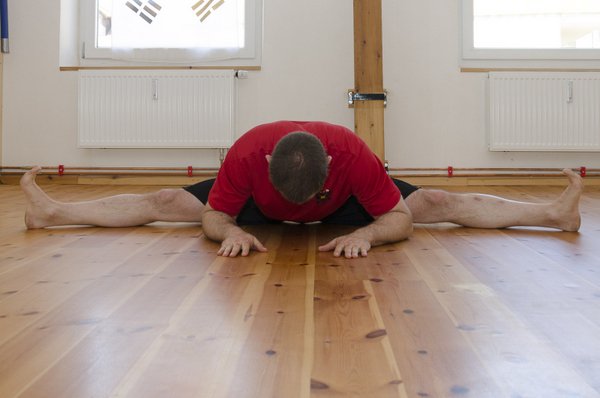
Side Split
The side split was my first split and it is a little easier than the front split for most people. I would not recommend to push both exercises hard at the same time.
Sit with a tall spine and open your legs until you feel a light tension on the inside of your thighs. Pull your toes to the knees and keep the knees tightly locked (pull your kneecaps upwards). Keep your lower back tight at all times.
Now try to tilt your belly button toward the floor. Go as far as you can without suffering too much and hold the position until it feels more comfortable – then open your legs more by pushing your heels away from you. Again hold this position and lightly rock your pelvis forward and back. If you feel you can go on–repeat the process. Try to hold the last position for 10 to 30 seconds before you slowly back off.
To get safely out of the stretch I like to lift both knees with the hands and bring the feet together. Stand up and move your hips.
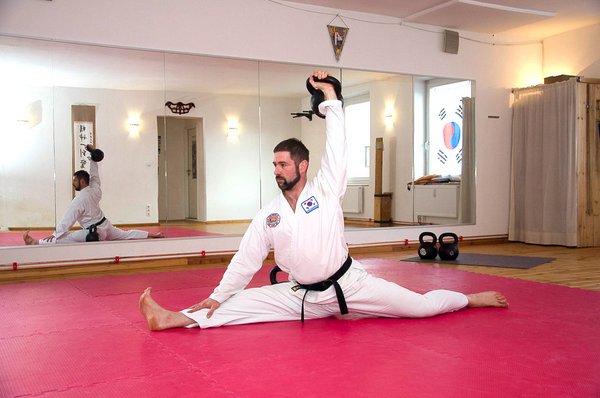
Front Split
If you have the side split, it is fairly easy to gain your front split also. For me the front split came almost automatically. Go into a lunge position and push your rear leg back as far as you can while keeping your knee away from the floor. Hold the position and try to go as low as possible without touching the rear knee to the floor. When you feel you cannot go deeper, push back even more until your forward leg is straight. Finally you will be able to touch your hip to the floor.
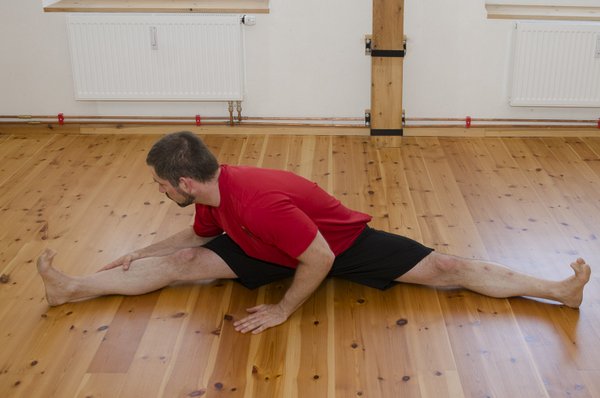
Seated Straddle with Rotation
Another way to get into the front split is to sit in a wide straddle, rotate the torso toward one leg, and push yourself up. As soon as you find your mid-line, let gravity take care of the rest. Use your arms to support yourself as much as you need.
Remember to go slowly with these exercises and back off when you need to. Enjoy the process and if you are diligent and dedicated, the full splits can one day be yours.
****
Florian Kiendl, PCC, RKC Team Leader, is a second degree black belt in Tae Kwon Do and runs a Martial Arts Gym in a small town close to Munich, Germany. In his search for ways to overcome the movement restrictions of his students (and his own) he found the PCC and now works to help as many people as possible gain back their strength and agility.
